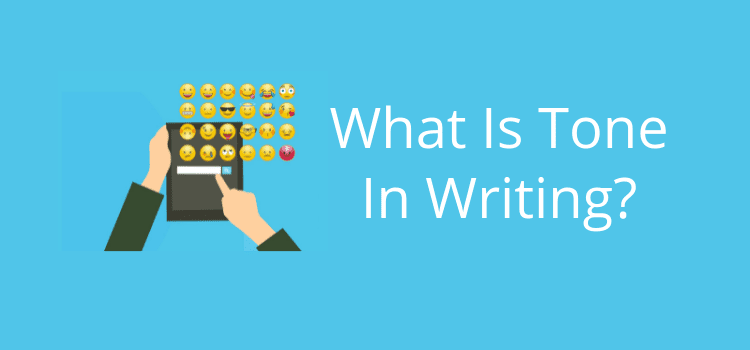
The easiest way to understand tone in writing is to think about emoticons.
When you send messages to friends, you often add an emoji to say that you are happy, sad, confused, or being sarcastic.
But you can’t add icons when you are writing blog posts, articles, or books.
Tone is a writing skill you can develop to improve your communication, clarity, and storytelling in content writing and books.
The difference between tone, style, and voice
For a new writer, these literary terms can be confusing.
Voice is who is telling the story. In literature, it is usually the narrator and the characters.
It uses a mixture of point of view, vocabulary, and syntax to make sentences flow in a coherent way.
Style in writing is used to suit a particular purpose.
Examples include descriptive, narrative, persuasive, expository, technical, and poetic.
For a book, the narrative style is usually the most appropriate. A user manual would use the technical style, and for content marketing, the persuasive.
If you were writing about travel and interesting places to visit, you would use the descriptive style.
Voice and style indicate what you say.
Tone, on the other hand, is how you say something.
By using different tones in writing, you can indicate the negative or positive emotions of the speaker.
Change the formality and tone
A simple way is to change the level of formality to apply a different tone and mood to a piece of writing.
When you are writing on any topic, the tone is the attitude you use to help your reader feel certain emotions.
You could use a casual tone, such as in this example.
“Hey, what’s up? I was just wondering if you’re free tonight.”
Sarcasm is another informal tone.
“Oh great, another meeting. Just what I needed today.”
You might recall your mother saying, “Don’t speak to me in that tone of voice!”
It probably wasn’t because of what you said, but how you said it that upset her.
Don’t use adverbs
One important aspect to note is that using adverbs in dialogue tags is not the ideal way to express emotion.
For example, he said angrily, or she said desparingly are poor ways to imply sentiment in a sentence.
When you are trying to use any type of tone, you need to craft it in your phrases, sentences, or utterances.
It’s about your word choice
![]()
It doesn’t matter what your subject matter is.
You can use either an informal or formal tone in your sentence structure.
You can’t add a smiley emoticon or wave your arms about in violent gesticulations.
But your writing can indicate happiness, sadness, anger, or surprise.
You convey it through your choice of words or from your viewpoint as a writer on a subject.
Examples of tone in writing
Let’s look at some sample phrases to help you understand how easy it is to use.
Surprise – Never in my wildest dreams did I think I would get a pay rise.
Threatening – We’ll discuss your position in my office at 2 o’clock.
Supportive – Don’t worry too much. Let’s have a chat about it all in my office at two.
Sarcasm – Oh, look. A pair of socks again for my birthday. You’re all heart.
Despair – Whatever I do, I’m always wrong in my father’s eyes.
Happiness – Jane was over the moon when her daughter received her law degree.
Shock – I nearly had a heart attack when I saw my phone bill. It was over $750!
Resignation – I don’t think I’ll ever find a publisher. But all I can do is keep trying, I suppose.
Anger – I’m fed up with all your lies. Pack your bags, and get out of my life!
Empathy – I know how you must be feeling. But I’m here for you whenever you need help.
As you can see from these quick examples, it’s pretty simple.
You can use it in article writing or the narrative and dialogue of a book.
It is especially useful to show your readers what is happening instead of telling them.
The beauty of tone is that you don’t need to use awkward dialogue tags and adverbs.
Summary
You can find many sites that give you a lot of examples of tone in literature.
But often, the selected quotes are complex and deep in meaning. Sure, they can be helpful.
If you want to start experimenting, it’s easier if you understand the basics.
You create the overall tone by using your sentence structure and choice of vocabulary.
When you get it right, you’ll know right away because you won’t need to describe what was said.
Related reading: Common Abbreviations We Use But Don’t Know The Meaning




Interesting post but isn’t the word “certainly” an adverb? Just sayin’.
It certainly is an adverb! But it’s not modifying a reporting verb. That’s where adverbs are a problem with tone.
Thanks for a useful post. I’m passing it on to my writing group. :)